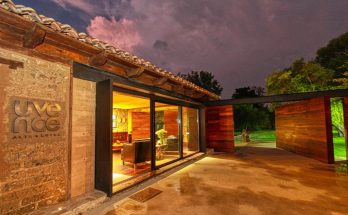Dzibilchaltun archaeological site is one of the major centers of the Mayan culture in Yucatan and of the Peninsula as a whole. It was discovered some years after Chichen Itza and Uxmal, but the first constructions date back to around 500 BC.

Dzibilchaltun Ruins
Dzibilchaltun covers an area of 16 square kms, with about 8,400 structures.
The settlements is of the concentric type and the nucleus, which covers about 25 hectares, contains numerous monumental structures. In the 3 kms of the central part of the site there are various groups of buildings, the remaining 13 square kms contain disperse groups of structures with pyramid and vaulted buildings.
Further away from the centre of this ancient city, there are structures with stepped platforms around plazas, and small unvalued pyramids.
Many of the constructions found at Dzibilchaltun archaeological site were built using the “Green Masonry” method, in which the stones are held together by chocks and mortar.

The vaults were constructed using the overhanging stones method. The facades were decorated with modeled plaster.

Within the archaeological site there are 12 stone roads of “sacbes” the major part join the centre with the out-laying constructions.
These roads are about 15 mts wide and they measure from 25 mts length to more than 1 km.
Dzibilchaltun is also a noteworthy site because it was inhabited for the longest period of time and has outstanding structures such as:
The Temple of the Seven Dolls
Considered a temple due to the characteristics of its construction. It has a square base with a central chamber encircled by a corridor. The roof of the central chamber forms a tower which apparently reached above the vaulted part of the building.
This structure also shows another feature uncommon in Mayan Temple of the Seven Dolls in Dzibilchaltun, Yucatan, it has windows next to two of its four doors. Over the Easter entrance, the inhabitants of the zone built a small altar decorated with painted hieroglyphics; they placed seven figurines, or dolls, on and in front of the altar as offerings, this is the reason the temple takes its name.
The Structure 38 Group
Heading from the museum of the Maya, you can see the residential area comprised of structures 384, 385, 386 and 38-Sub, one of the eldest vaulted structures in the site. Some archaeologists consider that this group represents a residential area with an area for worship, since large stone “metates” in the shape of square basins were found in some chambers. There is also found a tomb in the centre of the platform.
The Central Square
located to the south of the residential area. Among others, its found structure 44, a large palace with three chambers, one of the longest in the mayan area with 130 mts long and 35 entrances.Structure 44 in
The Open Chapel
At the beginning of the Colonial era, an open chapel with barrel vault and sacristy in one, was built in the middle of the Central Square. According to a carved stone found in what was the priest’s house, the chapel was built between 1590 and 1600. Dzibilchaltun.
The Standing Temple
In 1942 this was the only building standing with part of its roof intact, hence the name. It is also known as Structure 57 and it probably dates to the first half of the ninth century. Its architecture has features of the Early style with some influence from the transition to the Puuc style.
The walls are made of rough cut square stone blocks; the surfaces are covered with a finer layer of plaster than in older buildings, and the door lintels are made of monolithic blocks similar to those in Puuc style buildings. However, the vault is made of overhanging stones, and the base layer of blocks with large tenons.
Xlacah Cenote in Dzibilchaltun
The Xlacah Cenote. Xlacah means “Old Town” or “Old People” and this is the name of the cenote at Dzibilchaltun, one of the larger and deeper in Yucatan. Between 1957 and 1959 specialized divers explored the cenote and descended 40 mts; the experts say it goes down to this depth at a sharp angle and then levels our horizontally; it is not known where it ends. The divers rescued wood, bone and stone artifacts, as well as fragments of ceramics and slightly some complete pots. This cenote is actually available for swimming.
Facilities at Dzibilchaltun.
- Tourist Center
- Museum,
- Restaurant
- Rest Rooms
- Parking
- Crafts
- Books and Photographic Items
Undoubtedly, of the many places you can find in Mexico, this is one of the areas that almost no one knows, but you can come to enjoy and live an exciting adventure through the history of this mystical place of Yucatan and do not forget that you can also visit the magical town of Izamal and Xcambo.




